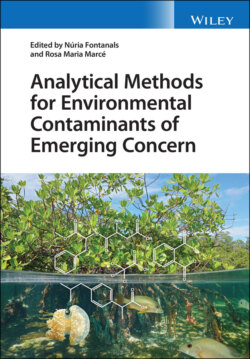Читать книгу Analytical Methods for Environmental Contaminants of Emerging Concern - Группа авторов - Страница 33
2.2 Sampling and Sample Preparation
ОглавлениеThe most commonly used method for the collection of environmental samples is grab sampling. Due to significant dilutions, the volume of samples, especially of drinking or marine water, should be sufficiently large due to the trace content of pharmaceuticals in this type of matrix. Water samples of 1000 mL are recommended for the determination of drug residues in drinking water, groundwater and treated wastewater (EPA Method 1694, December 2007, EPA-821-R-08-002). A different approach to monitoring the level of water pollution with pharmaceuticals is passive extraction, where the sampling process is carried out simultaneously with the extraction of analytes [26]. The use of passive extraction techniques has the advantage that the result obtained is a time-weighted concentration independent of the momentary and temporary variations in the concentration of the analytes. In the extraction of pharmaceuticals, the Polar Organic Chemical Integrative Sampler (POCIS) type sampler is most often used, in which the Oasis HLB sorbent is the acceptor phase (the same as in the case of SPE). In a paper by Bueno et al. [27] regarding the quantification of carbamazepine and its transformation products in French coastal waters using POCIS (Oasis HLB), the presence of 20 other compounds including β-blockers, lipid regulators, analgesics, antibiotics and antidepressants was revealed. In turn, Rimayi et al. [28] used the Chemcatcher passive sampler deployed in environmental waters over a period of 14 days. This resulted in the identification of over 200 compounds including pesticides, pharmaceuticals and personal care products, drugs of abuse and their metabolites in environmental waters. In recent years, the possibility of using other receiving phases in POCIS in order to increase the range of polarity of isolated compounds, namely Strata-X Strata XAW or Oasis WAX, Oasis MAX, molecularly imprinted polymers (MIP), carbon nanotubes and ionic liquids, has been described [29–32]. Although both standard POCIS design and prototype devices have great potential applications in water monitoring, there is still a gap between the determination of sampling frequency in the laboratory and its applicability in the field.
Extraction procedure is the second after sampling largest source of errors in determining the actual content of pollutants in the environmental samples. Thus it is important to select the proper procedure of extraction according to the selected analytes and the type of the studied matrix. The procedures used to extract pharmaceuticals depend mainly on the physical state of the matrix. Therefore the procedures can be divided into those targeting soil and sediment samples and those for water samples – mainly marine and fresh surface water, but also wastewater and drinking water.
